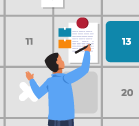
If you don’t know how to plan—plan for the day, plan the project, or plan for the new business—it can be hard to know where to start.
Whether you’re trying to be more productive throughout the day, power through a big project, or launch a new business venture, it’s important to have a plan. The right plan acts as a roadmap; it gets you from where you are now to where you want to be.
But not everyone is a natural planner. And if you don’t know how to plan—plan for the day, plan the project, or plan for the new business—it can be hard to know where to start. You need a plan for how to start planning.
Not to worry—we’ve got you covered. Let’s take a look at a step-by-step guide on how to build an effective plan (and become more productive, efficient, and effective in the process):

Get the Right Planning Tool (or Tools)
Planning is like anything else; in order to do it effectively, you need the right tools. So the very first thing you should do during the planning process, regardless of what you’re planning? Get the right planning tool.
The main tool you need for effective planning is a tool to manage your tasks and to-do’s—and the “right” tool to do that? It’ll vary from person to person.
If you’re the kind of person who likes to write things down, buying a planner (or even just a planning notebook) can be helpful.
If you want to make planning a collaborative process with your team, a project management tool could be a good option. Some tools you might want to consider include:
If you live by your calendar, you can build your plan right into your calendar app. Or you can use some combination of some or all of these tools.
The tools you use to build your plan are up to you—but before you dive into the planning process, make sure you have the right tools on hand to help you get organized, stay organized, and hold yourself accountable for following through on your plan.
If you want to learn more about Kanban planning, check out our article on the topic.

Brain Dump Your Tasks
When you’re formulating a plan, you’re taking a large objective (whether that’s launching a new business, navigating a project, or making the most effective use of your time throughout the day) and breaking it down into smaller, actionable tasks. So, whatever it is you’re trying to plan, you need to go through that breaking down process.
Whatever your objective is, think of all the tasks that need to be accomplished in order to achieve that objective and write those tasks down. Don’t worry about putting them in order or thinking about when they need to get done; just get them out of your head and onto a piece of paper.
Planning examples
-
If you’re trying to plan a new website launch, your tasks might include buying a domain, writing the website copy, choosing a color palette, designing the website structure, installing a pop-up to collect leads, and building out e-commerce functionality to sell products.
-
If you’re trying to plan out your day, your tasks might include having a team meeting, getting the laundry done, paying contractor invoices, going for a run, troubleshooting an issue with your team collaboration software, responding to emails, and having a performance review with one of your employees.
-
If you’re trying to plan for hiring a new position in your business, your tasks might include defining the key job responsibilities, writing a job description, posting the job on relevant job sites, scheduling interviews, and creating a sample project for your final candidates.
Whatever it is you’re planning, take the time to brainstorm every task—big or small—that you’ll need to check off your to-do list in order to move from the planning stage to the “finished” stage.

Organize, Prioritize, and Assign
Once you have all your tasks written down, it’s time to organize, prioritize, and assign them.
Organize
First comes the organization. There are a number of ways you can organize your tasks—and the best way to organize is going to depend on your ultimate objective. So, for example, if you were planning for your day, you might organize your tasks into “personal” and “work” categories. If you were planning something on a larger scale, like a new business launch, you might organize your tasks into categories like “strategy,” “marketing,” “administrative,” and “research.” How you organize them is really up to you; just organize them in a way that makes sense for you and your ultimate objective.
Prioritize
Once your tasks are organized, then it’s time to prioritize them. The Eisenhower Matrix (also known as the Urgent-Important matrix) is a great tool for prioritizing tasks and figuring out what needs to be done, when, and by who.
To use the Eisenhower Matrix, you first want to organize your tasks into one of four categories:
-
Urgent and Important. Tasks that fall into this category are both time-sensitive and important to your overall goal. Urgent and important tasks should be at the top of your priority list.
-
Urgent and Non-Important. Tasks that fall into this category might not be hugely important to your overall goal, but they need to be done—and they need to be done quickly. Urgent, non-important tasks are great to delegate to other people on your team.
-
Non-Urgent and Important. Tasks that fall into this category are an important part of hitting your overall goal, but they don’t necessarily need to be done right now. Non-urgent and important tasks should be scheduled for a later date.
-
Non-Urgent and Non-Important. Tasks that fall into this category are neither urgent/time-sensitive or important to your overall goal. Non-urgent and non-important tasks are time sucks that will hinder your overall productivity—and the best thing you can do is get rid of them.
Assign
Once you’ve prioritized your tasks, it’s time to assign and schedule them. Using your planning tool (whether that’s a physical planner, a project management software, a calendar app, or some combination of the three), start assigning tasks and deadlines to yourself and your team.
Start with your urgent and important tasks to make sure they get top priority on your schedule. Then, tackle the urgent and non-important tasks. (If you work with a team, these tasks are ideal for delegating; if not, you can assign and schedule them for yourself after you finish the urgent and important tasks.) Lastly, make room on your schedule for the non-urgent and important tasks and assign them for a future date; that way, they’re already on your schedule once you’ve worked through your more urgent to-do’s. (And again, any non-urgent and non-important tasks? Get rid of them.)
As you work through each of your tasks, more to-do’s will arise—and you’ll need to organize, prioritize, and assign accordingly. But continually organizing, prioritizing, and assigning your tasks—and then checking those tasks off your to-do list each day—is the active planning you need to increase efficiency and productivity and get things done.
Plan Your Way to Higher Productivity
As the old saying goes, “failing to plan is planning to fail.” But now that you know how to plan effectively—whether you’re planning for something small, like your daily schedule, or something big, like a new business venture—you have everything you need to plan your way to higher productivity, efficiency, and success.




